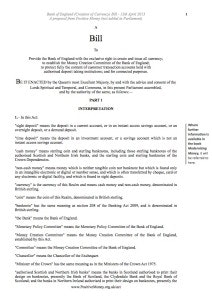Draft Legislation

[left width=’30%’]

[/left]
[right width=’70%’]This unofficial draft bill shows how our reforms could be implemented in law in the UK parliament, to remove the power to create money from banks and transfer it to a democratic and accountable process, working in the public interest.
We’re not currently campaigning for this bill to be introduced into parliament, because there’s a lot more education and spreading the word to do before legislation has a chance of being successful. But the draft legislation is intended to show civil servants and politicians how it could be done.
[div class=’box-download’]Download Here (Free, PDF, 22 pages)[/div]
[/right]
More Details
The legislation is split into 7 parts and 7 schedules. The parts lay out the main principles of the reform, while the schedules have the finer details. (We’ve followed the standard format for UK legislation – other countries will have different styles).
The Parts
Part 1 defines the terms used through the legislation.
Part 2 explains that the power to create money will be returned to the state, via the Bank of England, and that the Bank of England’s Monetary Policy Committee will be replaced by a Money Creation Committee (MCC), which will be responsible for creating money in line with inflation (or other) targets set by Parliament. The money created by the MCC will be transferred to the government account and can be spent by the government along with all other tax revenue.
Part 3 establishes the Money Creation Committee (MCC) and sets up checks and balances to make sure that the Committee is accountable to Parliament and does not have the freedom to abuse their powers.
Part 4 makes some other changes to the Court of Directors of the Bank of England, to reduce the amount of power concentrated in the Chancellor (the UK’s finance minister) and transfer that power to the Treasury Select Committee, which is a group of Members of Parliament made up from all the major parties.
Part 5 briefly explains the establishment of the different types of accounts necessary to make the reform work. Further detail is in Schedule 1.
Part 6 explains what will happen in the transition process and sets up a facility to make sure that bank lending to productive parts of the economy does not fall.
Part 7 makes some changes to the way the Bank of England works to close down certain assistance schemes that are no longer needed as a result of the reforms.
Part 8 briefly explains what happens if a bank becomes insolvent and how bailouts can be avoided.
Part 9 lays out some activities that will be criminal offences after the reforms have been implemented.
The Schedules
Schedule 1 provides the finer details on how Transaction Accounts and Investment Accounts will work, and explains the structure of Investment Account guarantees.
Schedule 2 details the accounts that the Bank of England will provide to each bank – the Operational Account, the Investment Pool and the Customer Funds Account.
Schedule 3 explains how banks will be able to make loans in such a way that does not create money.
Schedule 4 provides some detail on how cash will be held.
Schedule 5 is a minor point explaining the details of the account that the Bank of England will provide for central government
Schedule 6 is a minor point establishing an account at the Bank of England for the Bank of England’s own operating funds.
Schedule 7 explains how banks can be allowed to fail with no interruption to the payments service, no loss to Transaction Account holders, and no need for bailouts.
[div class=’box-download’]Download Here (Free, PDF, 22 pages)[/div]